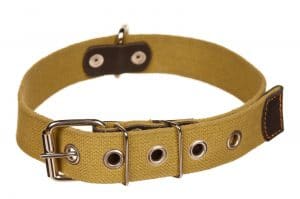![]()
HeelBoyHeel is reader supported. When you buy through any link on our site, we may earn an affiliate commission, but never at any extra cost to you.
When you are trying to train your dog, whether he is a puppy or an adult dog, one of the ‘solutions’ you’ve probably come across is a shock collar. Although it may seem like a simple solution, I want to explain why I think you should NOT use a shock collar to train your dog.
I’m not saying that you NEVER should use this, but it definitely should not be your first choice.
Dog Training Basics
So going back to basics, with any dog training you are after one of 2 things:
- you are trying to get your dog NOT to behave in certain ways – so for example to stop barking excessively, to stop being aggressive, to stop jumping up
- or you are trying to encourage your dog TO act or behave in a certain way – maybe to sit, stay, or retrieve
One way that you have probably come across online to to try to do both of these is by using shock collars (also referred to as remote training collars, training shock collars, anti-bark collars, e-collars, or electronic collars).
Some dog owners and trainers will use these for so called ‘positive punishment’. In this case, the shock comes after the negative behaviour, and so teaches the dog to stop barking, jumping up, or whatever – so that he or she does not get another shock.
And some trainers use ‘negative reinforcement’ to train dogs to do certain things. In this case, the dogs will be asked to do something, then the electric shock starts. The trainer will only stop the electric shock when the dog does what has been asked. The idea is, once the dog is trained, they will always carry out the requested instruction quickly, in order to avoid being shocked.
But using shock collars is controversial – and with good reason.
In fact any punishment in dog training is a controversial subject among trainers. There are many ways to go about punishing your dog for bad behavior: correction, restriction, an aversive followed by a reinforcer, and negative punishment.
But the truth is that punishment of any sort should only be used as a last resort.
“Using punishment is more a sign of a bad trainer than a bad dog“
Dog Behaviour
Before we talk about shock collars, let’s look at what we need to know about dogs and dog training in general.
Dogs are like kids: they need the right amount of positive reinforcement to be happy, healthy, and obedient. It’s so important to train your dog properly so that they understand what you want them to do.
Dogs are active, intelligent, and social animals, and they need a lot of mental stimulation. Dogs who don’t get enough exercise, who are left alone for long periods of time, or who are not allowed to live in an enriched environment can become anxious, possibly destructive, and display other forms of ‘bad’ behaviour.
They are creatures of instinct and they respond to emotions, not reasoning. Without the positive guidance of a human, they will never learn what is expected of them in different scenarios.
All this means your first option should always be to train your dog in a positive way, not negative punishment – and shock collars are definitely a form of negative punishment.
Collar Training For Dogs
Collar training itself is NOT necessarily negative. There is a distinction to be drawn between aversive collars – which are collars that rely on physical discomfort or even pain to teach a dog what not to do – and regular dog collars – which can be used as a part of humane and effective dog training.


Using aversive collar training is an old-school training method, and includes not just e-collars, but other types of dog collars, like the choke collar or choke chain – which many people have always considered to be a form of animal cruelty.
And while the collars and the technology that drives them have become more advanced, the principles remain the same.
So What Exactly Is A Training Shock Collar?
The shock collar is a relatively new form of correction for the wayward dog and is used to correct unwanted behaviors in dogs. They are often used in cases where the owners are not willing or able to spend the time and energy needed to train a dog using a more effective type of correction. As an ‘easy fix’ solution, they have become a popular training device for some dog owners.
There are many types of these handheld devices and many types of collar to choose from: flat collar, head collar, dog harnesses, prong or pinch collar, martingale collar, spray collars, slip collars, bark control collars, remote training collars, and so on.
While they have been around for decades, their prevalence on the market today is a result of improvements in technology. With advances in microprocessors, these collars can now accurately deliver electric shocks to dogs at a distance of up to 400 yards. This technology has many uses in animal training, but there are serious repercussions of using these for dog training.
The way the electronic collar ‘works’ is that it gives an electric pulse as a form of punishment for aberrant behavior.
Training collars use an electric current, a signal to remind the dog when it does something it has been told not to. These collars for dogs are designed to fit around a dog’s neck, usually come with rechargeable batteries, and are equipped with electrodes that receive electric signals transmitted by remote control.
The electric shock is applied by pressing a button on the remote control, which is itself usually strapped to the wrist of the person using it and also powered by batteries.
The electric signal is a controlled sudden jolt of electricity, a beep that is delivered to the dog’s neck. This static shock sends a message to the dog’s brain which is translated to either stop or continue with the command given.

They are most often used for training a dog not to bark – hence the other common name anti-bark collar or bark control collar. This is also referred to as automatic bark correction.
But these collars can also be used to train aggression behavior, protect the handler, and inhibit endangering behaviors.
So the electric training collar is an instrument that is used to provide a painful shock to the dog’s body in order to distract it from undesirable, negative behavior.
These may be appropriate in extreme cases, when other more traditional methods of training and correction have failed. But they should never be used as a cure-all, and only ever as a last resort.
Aside from the animal welfare argument – which is difficult to argue against – they are simply not successful for all dogs, and should not be mistaken for a miracle cure, even if they are advertised as such.
These shock collars and bark shock collars can be dangerous if used improperly, can result in some serious side effects, and can themselves create anxiety and fear in your dog, which can lead to aggression.
So the question is, are shock collars ever an effective way to train a dog?
As a general rule, I would never recommend electric training collars for any dog.
With the exception of very extreme cases – and even then only under the supervision of a trained professional – I believe that shock collars should never be used to train a dog – and I’ll explain exactly why and look at the alternatives to these training collars below.
6 Reasons Not To Use A Shock Collar On Dogs
There are lots of reasons, but the most obvious one is…

Do You Really Want To Hurt Your Dog?
Shock collars are inhumane simply because they use physical pain to correct unwanted behavior. At best they cause discomfort and stress, and at worst they can cause quite serious injury by electric current passing through the body.
The American Society for the Prevention Cruelty to Animals (ASPCA), and many other organizations believe these collars are a form of abuse:
“The ASPCA is opposed to any training equipment that causes a pet to experience physical discomfort or undue anxiety.”
This form of training is outdated, and in my opinion, cruel, which is reason enough not to use them.
But there also are other reasons.

Using An Electric Shock Collar Can Damage Your Relationship With Your Dog
A lot of research shows that using an e-collar can have a very negative effect on your relationship with your dog – not surprising really, as you are using the collar to inflict pain and discomfort.
Your relationship with your dog is built on love and trust. If you start to inflict pain and suffering – even with the best of intentions – you will inevitably undermine that trust, and damage your relationship.
Studies have shown the negative psychological, physical, and emotional effects shock collars can cause, not only in dogs, but also in the person inflicting the static shocks.
Using an electric training collar will make your dog start to associate their owner with pain, which can cause him or her to be nervous or scared around you. Once formed, these associations will not be easy to break.

Using Shock Collars Impairs Communication Between You And Your Dog
Communication is at the heart of any relationship. It’s also at the heart of a close relationship with our dogs.
Dogs are unique and intelligent beings that communicate in many ways. They have a range of vocalizations from barks and growls, to whines and whimpers. They also have a wide range of body language such as tail wagging and posture that help them communicate certain emotions.
The ability to talk to your dog is one of the keys to a happy life with your dog. Humans have the ability to communicate with dogs mainly in two ways: verbally, and body language.
Verbal communication includes speaking to the dog in a calm voice and using positive reinforcement (e.g., telling the dog “Good dog!”). Body language includes things like patting your leg and using the right tone of voice to get the dog to come to you.
Shock collar use is not a form of communication, it”s a form of punishment – and arguably a form of abuse.

Shock Collars Can Make Your Dog Feel Confused, Unsure And Insecure
Ironically, despite being used to treat dog aggression, shock training often encourages the dog to behave more aggressively, not less.
The execution of the ‘positive punishment’ may be easy enough in theory, but there is no guarantee your dog won’t form unintended associations when they receive the shock from the collar. This means that anything that the dog experiences at that time may become associated with the negative experience of the shock.
So for example if you are trying to stop your dog barking, but at the same time he sees a cat in the garden, or a neighbour passing by, or any other seemingly innocuous event, he will associate this with the electric shock instead.
When he next receives a shock, he doesn’t understand why and will feel confused, unsure, and insecure. Now he will be even more motivated to bark when he sees these things again the future.
For any dog, as well as being ineffective, this sort of unpredictable punishment will cause him direct pain and anxiety – which is the root cause of aggression.

Shock Collars Can Make Your Dog Fear Other Dogs Or Other People
Electric shock treatment may make your dog be scared and fearful of other dogs, or new people – and again he will be more prone to aggression.
Do a search on the internet and you will find a lot of pages about how to use these devices in a positive way. What they don’t realize is that these shocking devices make your dog associate certain safety behaviors with negative sensations. This means that the reaction of your dog may be a negative one and, even if he listens when he is shocked, he will not associate it with anything positive.
Humane training methods such as positive reinforcement are much more effective, and do not have any of the potential downsides.
Positive affirmations will always be more effective method of correction in behaviour than negative ones.

Shock Collars Can Be Potentially Dangerous For Your Dog’s Health
There are also concerns over the safety of these collars, as they can sometimes cause unintended injury. Electronic collars can cause the dog’s heart to race and even puts them at a risk for cardiac arrest.
There is no need to put your dog in such serious danger.
In 99% of cases, these devices are not necessary and can be replaced with more caring and more effective training techniques. There are more humane options available to all dog owners.
So What Is The Alternative To Dog Shock Collars?
Everyone has their own perspective of dogs and the difference between a good and bad dog is a matter of opinion. There are some dogs who will growl or bark at other people they do not know well, but there are also lots of dogs who are instinctively calm and friendly.

But for me, there is no such thing as a bad dog… only a bad owner.
Every dog is good, as long as they are well treated and cared for, and trained properly and humanely.
Above all else, they need to feel secure and know exactly what’s expected from them. All dogs naturally want to please their owner, so it’s your job to make clear to your dog exactly what you want them to do – and what ‘problem behaviour’ you do NOT want them to see them do.
No matter what problems you are having with your dog, you can train him to behave exactly the way you want him to – without the need to use any sort of shock collar or carry out any other punishment. And you do not need to hire expensive dog trainers to help stop any problem dog behaviour.
The Online Dog Trainer has identified 5 ways that can help you transform ANY dog into a calm, loving and obedient member of the family – even if you feel like you’ve tried everything and nothing has worked.
Click here to select whatever area you need help with the most, and watch the best video to help you and your dog.
Remember, dog training a dog should be fun, not an act of tyranny! And with the right guidance, it is immensely pleasurable, both for you and for your dog.